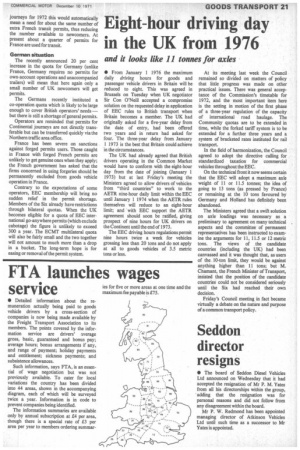Eight-hour driving day in the UK from 1976
Page 23

If you've noticed an error in this article please click here to report it so we can fix it.
and it looks like 11 tonnes for axles
• From January 1 1976 the maximum daily driving hours for goods and passenger vehicle drivers in Britain will be reduced to eight. This was agreed in Brussels on Tuesday when UK negotiator Sir Con O'Neill accepted a compromise solution on the requested delay in application of EEC rules to British transport when Britain becomes a member. The UK had originally asked for a five-year delay from the date of entry, had been offered two years and in return had asked for four. The three-year delay from January 1 1973 is the best that Britain could achieve in the circumstances.
The UK had already agreed that British drivers operating in the Common Market would have to conform with the eight-hour day from the date of joining (January 1 1973) but at last Friday's meeting the Ministers agreed to allow drivers of vehicles from "third countries" to work to the AETR nine-hour daily limit within the EEC until January 1 1974 when the AETR rules themselves will reduce to an eight-hour limit; and with EEC support the AETR agreement should soon be ratified, giving prospect of nine hours for UK drivers on the Continent until the end of 1973.
The EEC driving hours regulations permit nine hours twice a week for vehicles grossing less than 20 tons and do not apply at all to goods vehicles of 3.5 metric tons or less. At its meeting last week the Council remained so divided on matters of policy that little progress was made on other practical issues. There was general acceptance of the Commission's timetable for 1972, and the most important item here is the setting in motion of the first phase of a three-year regulation of the capacity of international road haulage. The Community quotas are to be extended in time, while the forked tariff system is to be extended for a further three years and a system of bracketed rates instituted for rail transport.
In the field of harmonization, the Council agreed to adopt the directive calling for standardized taxation for commercial vehicles throughout the EEC.
On the technical front it now seems certain that the EEC will adopt a maximum axle weight of 11 or 11.5 tonnes; the idea of going to 13 tons (as pressed by France) or remaining at the 10 tons favoured by Germany and Holland has definitely been abandoned.
The Ministers agreed that a swift solution on axle loadings was necessary as a preliminary to agreement on many technical aspects and the committee of permanent representatives has been instructed to examine the arguments for 11, 11.5 or 12 metric tons. The views of the candidate countries (including the UK) had been canvassed and it was thought that, as users of the 10-ton limit, they would be against anything higher than 11 tons; but M. Chamant, the French Minister of Transport, insisted that the position of the candidate countries could not be considered seriously until the Six had reached their own decision.
Friday's Council meeting in fact became virtually a debate on the nature and purpose of a common transport policy.




































































































